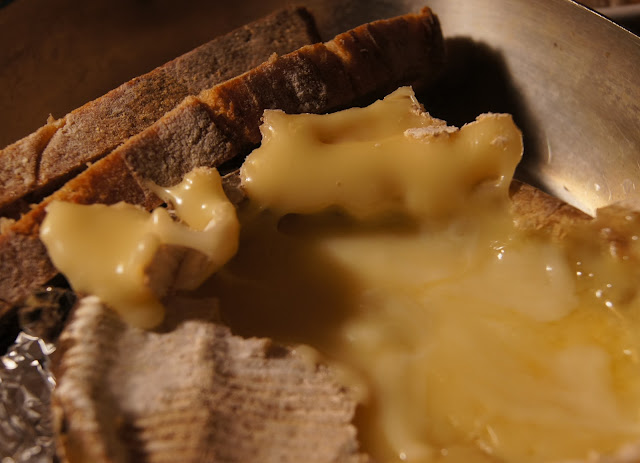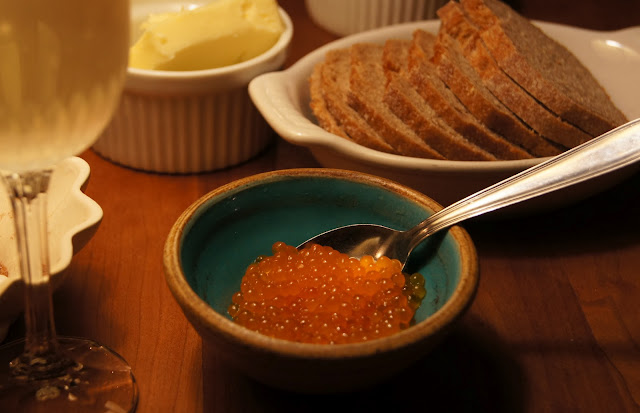Braising season is full upon us, that time of year when
meats and roots and wines and seasonings convene in the stew pot, the dutch
oven, the cocotte, even the crockpot, and slowly simmer to succulence,
producing homey, savory dishes that warm the hearts of those chilled of cheek
who come in from the frosty outdoors to the warm kitchen with grateful appetite
and glasses all a’fog. Or perhaps it’s
incorrect to speak of braising season, since that occupies better than half the
year in these parts; more like braising semester, plus. Or a twist on the old joke about the two
seasons of the Northland—road repair, and braising season.
I do love a braised meal, both for the simplicity and for
the phenomenally satisfying results. But
given that our climate is more than generous in providing us opportunities to
enjoy braised dishes, it’s wise to look for ways to keep our simmered suppers
interesting. Case in point, today’s
plate of Honey Hua Jiao Braised Lamb Shoulder with Turnips. That’s a mouthful—and
a delectable one, though I say so myself.
Let’s break it down.
The danger with braised dishes is that they can all start to
taste the same—the pot roast factor, if you will. Exactly what is comforting about this type of
cooking is what can also make it dull.
The deep, meaty flavors imbue everything in the pot, and without some
thoughtful flavor additions, the end result can be kind of
one-dimensional. So we look for flavors
to counter-balance the meaty, salty, and fatty; we want acid, maybe even a
little bitterness, and perhaps sweetness, and interesting spice.
This dish has them all:
acid from wine, cider vinegar, and honey; bitterness, just a smidge,
from the turnips; sweetness from the honey, of course, and also the turnips,
shallots, and garlic; interesting spice, from the hua jiao, aka Sichuan
peppercorns, and my beloved thyme, which goes so well with lamb and with honey.
I think it’s about time for hua jiao to burst upon the
American culinary scene. It’s such an
intriguing, appetizing spice, I think it’s a simple matter of unfamiliarity
that keeps it on the back shelf—or, more literally, on some dusty shelf in a
corner of the Asian market, where it may be labeled Sichuan pepper, but just as
likely flower pepper (the literal translation from Mandarin), dried pepper, or
even xanthophyllum (the plant genus from which it comes, a type of “prickly ash”
related to citrus). For a long time it
was hard to find good hua jiao; I don’t know if mainstream sources like Penzey’s
even carry it. What I’ve been finding in
my local Asian markets lately is pretty good.
But if you happen to travel to China
Hua jiao is the spice responsible for the ma, numbing
quality, in Sichuan
You could put the hua jiao in cheesecloth and remove it at
the end of cooking, but I like to bite into the individual peppercorns, which
will have lost most of their numbing quality in the long cooking, but which
still provide intriguing bursts of flavor.
I only made this dish for the first time last night, and as
soon as the various components began coming to mind, I started to write it
down, thinking this might be something I might want to replicate, and pass
along. We were not disappointed. Served over soft polenta, with the brothy
sauce combining all the aforementioned flavors beautifully, still allowing the
individual elements to come through, it was beyond satisfying.
The lamb was from the Lamb Shoppe via Seward Co-op, a lovely
piece of shoulder that actually contained the end of the rib rack—just spectacular
meat. Anyone who thinks they don’t like
lamb should give Lamb Shoppe meat a try.
Often when people say they don’t like lamb, it’s because the lamb they’ve
had was closer to mutton. Knowing your
source in matters of meat can make all the difference.
Honey Hua Jiao Braised Lamb Shoulder with Turnips
Serves four
3 pound lamb shoulder, bone in
1 ½ cups stock, water, or a combination
½ cup dry white wine
2 tablespoons honey
1 tablespoon apple cider vinegar
¾ teaspoon whole hua jiao, Sichuan
6 to 8 small shallots, peeled
6 cloves garlic, peeled and halved the long way
A few sprigs thyme
Salt and freshly ground glack pepper
4 small turnips, quartered
Butter
Season the lamb with salt and pepper. In a dutch oven or similar, heavy-bottomed
pot, brown the lamb in a little bit of oil (I used Smude sunflower). Working over medium-high heat, brown it well
on all sides.
Combine the stock, wine, honey, and vinegar, stirring to mix
well. When the lamb is browned, remove
it from the pan and deglaze the pan with the combined liquids, scraping up the
brown bits with a wooden spatula. Return
the lamb to the pan along with the shallots, garlic, thyme, and hua jiao. Add a couple good pinches of salt and a few
coarse grinds of black pepper.
Bring to a simmer and place, partly covered, in a 350 oven. Roast for 30 minutes, then turn the lamb over
and cook another 30 minutes. Remove the
lid, add the turnips, and raise the heat to 425. Continue to roast, turning and basting
occasionally, for about another 45 minutes, until the turnips and lamb are both
tender.
Remove the lamb from the pot and let it rest for 10 minutes
before serving. While the lamb rests,
reduce the cooking liquid on the stovetop to your desired consistency—I like it
fairly brothy, but with a bit of viscosity.
Swirl in a knob of butter at the end, if you like, taste for salt. Serve over polenta, noodles, or rice.


















































